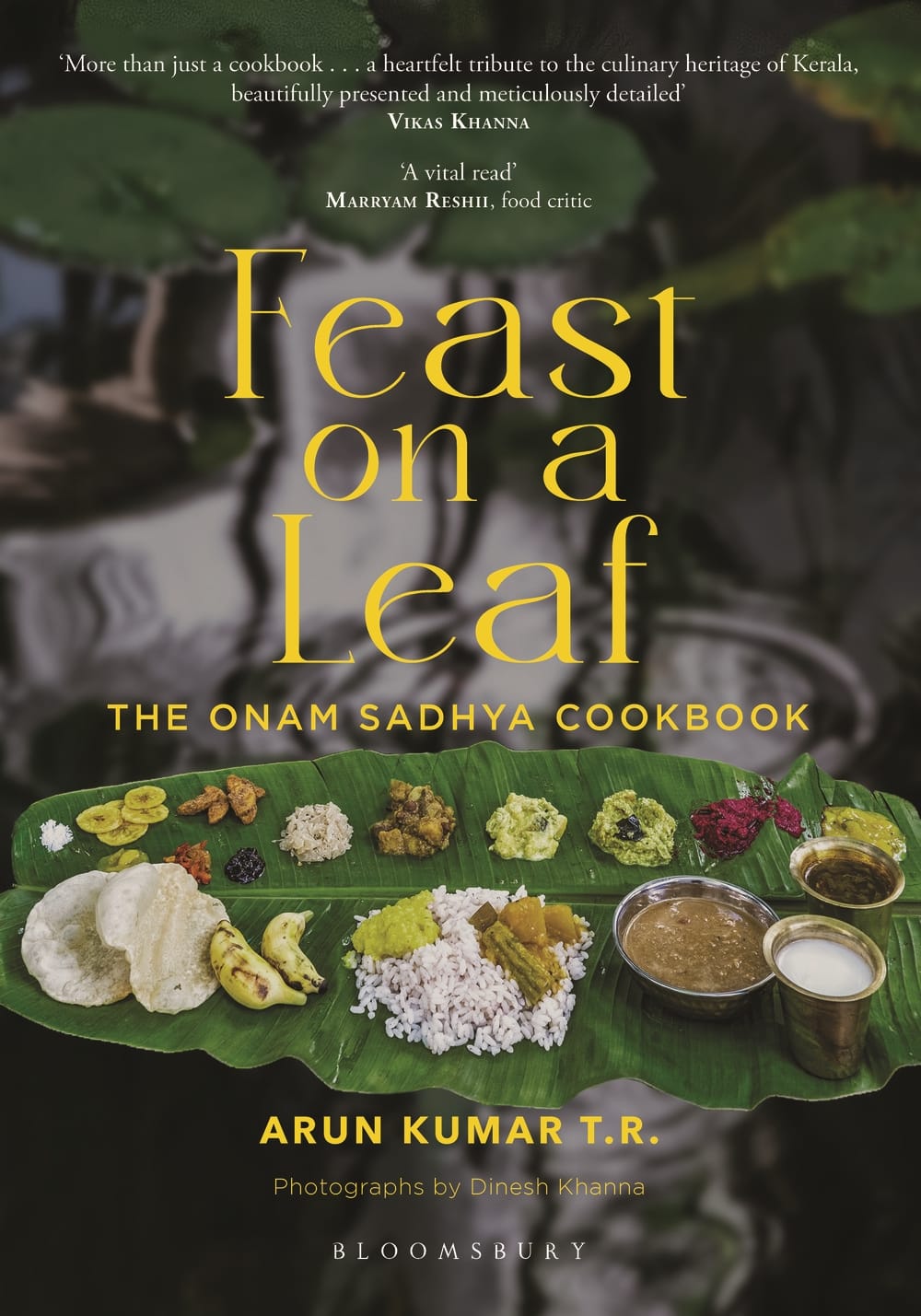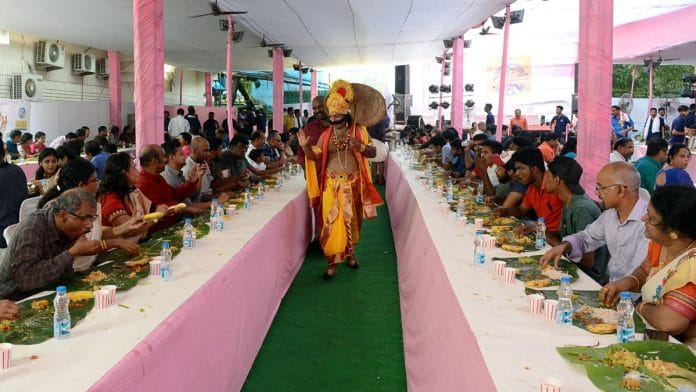Serving an Onam sadhya is quite a challenge, and one which goes beyond simply cooking the twenty-four-plus dishes. If it is a family sadhya, confusion and chaos sets in from the moment you begin placing the leaves on which the meal will be served.
Should the narrow tail end of the leaf be on the left or right? There is some disagreement about this. The tail end should be on the left of the person who is eating. Sometimes you do not get leaves which have a tail and a head, they are almost rectangular pieces because they have been trimmed to remove the torn portions. In this case the leaf could be placed without bothering about left and right. This was just one of the problems I faced when I managed the first Onam sadhya at the restaurant I was heading.
The left-and-right business seems simple to understand, but there is a lot of confusion when you are in the centre trying to explain it to the serving staff. While I was doing my best to demonstrate the left and right side of the leaves from the point of view of the person being served, my restaurant manager decided to make it even simpler: he told them to place the leaf with the tail to their own right.
We started a mock drill. It led to the leaves being laid out all wrong. The manager was adding to the mayhem by screaming, ‘Tumhara left kaunsa hai … is side se right … nahin, is side se right.’
I put a stop to the whole exercise. Back to square one. The instruction was simple. Place the leaf with the tail to the left of the person eating. It worked after a few tries. I could see some service staff standing at the table, twisting their heads to see which way the person would be seated, then placing the leaf correctly.
The manager, of course, wanting to have the last word, suggested that we cut off the tail and use rectangular pieces of the leaves; that way there would be no confusion. He would understand later that it was simpler to use the whole leaf as service would become easier. Using a full leaf, with a narrow tail end and a broad head end, fits into the serving scheme of a sadhya. And what is that?
The more people you talk to, the more variations you get. And if you begin checking online you may have to postpone your sadhya for a year as you wallow in a sea of confusion, and endless permutations and combinations.
Meanwhile, at the front of the house in the restaurant, as the leaves kept going left and right there was another problem brewing at the back of the house, in the kitchen. Many of the chefs were from Tamil Nadu and they had their own versions for the preparation of dishes, especially the sambar, avial, kootu and thorans. This is not the place to get into the debate of who was right.
To me, it was clear. It was Onam. We were to serve a traditional Nair sadhya, influenced by what was served at my tharavad home. So, days before the meal, through many trials, much to the disapproving looks of the chefs, I had to modify the recipes so we could come as close as possible to the sadhya I had in mind.
The avial became a bone of contention. My head chef wanted to play with colours – rightly so, to an extent – and wished to introduce vegetables like carrots to add a touch of orange to the otherwise yellowish curry with green highlights. This led to me lecturing him about how carrot was not a vegetable native to Kerala, and the concept of an avial with four seasonal vegetables: two types of pumpkin – yellow and white – raw banana and string beans. If required, one of the vegetables, preferably the string beans, could be replaced by yam. Over the years, after a lot of appreciation from clients, the chefs got happier about following my Nair recipes.
Back to the front of the house. The service staff and the leaves had settled into the right orientation, but the serving of items was a more daunting task. The trays, which the service staff normally used with utmost ease, were replaced with chomukhas serving vessels with four containers. The staff’s trousers were replaced by mundus (the sarong-like garment worn in many parts of South India). They were very excited, but when they tried walking they looked like geishas in kimonos, taking short, shuffling steps, gingerly and slowly, afraid the mundu would come off.
Every day, for about a week leading up to the Onam sadhya, the manager’s normal morning and evening briefing was extended by thirty minutes as he put the service staff through their paces in mundus. He would make them walk up and down the length of the restaurant, getting them to slowly be more comfortable and easier with their strides.
Then came the order of serving the various items and their placement on the leaves. That added more time to the briefing. At first, on a blackboard, I drew out the leaf and explained where each item had to be served. The manager repeated this exercise daily, turning it into a quiz by getting the staff members to mark the placements on a leaf drawn on the blackboard. I pitied them at one level. It was not only the right placement they had to memorise, but also the names of the dishes. The restaurant menu, in its Kerala vegetarian section, only had a few sadhya items like avial, thoran, erissery and pachadi.
A few days before the big day, the kitchen did a couple of full trials and we had the staff carry out service on a mock table. The manager had distributed chomukhas to a few, some were given responsibility to handle the accompaniments, some the rasam, buttermilk and payasams that were to be served in glasses and bowls. A hesitant start slowly but surely moved on to a fairly smooth execution. They took their time and referred to the blackboard when in doubt. But the mock trial was deceptive.
On Onam it started with the manager and me going around tables correcting the placement of some leaves. By and large it was fine. Before people walked in, we supervised the placement of the accompaniments. That was also fine. Then, the storm hit. Customers began walking in simultaneously, and as it happens, every table was in that much more of a hurry than the next. They all wanted to be served first.
 This excerpt from Feast on a Leaf: The Onam Sadhya Cookbook by Arun Kumar TR has been published with permission from Bloomsbury India.
This excerpt from Feast on a Leaf: The Onam Sadhya Cookbook by Arun Kumar TR has been published with permission from Bloomsbury India.






